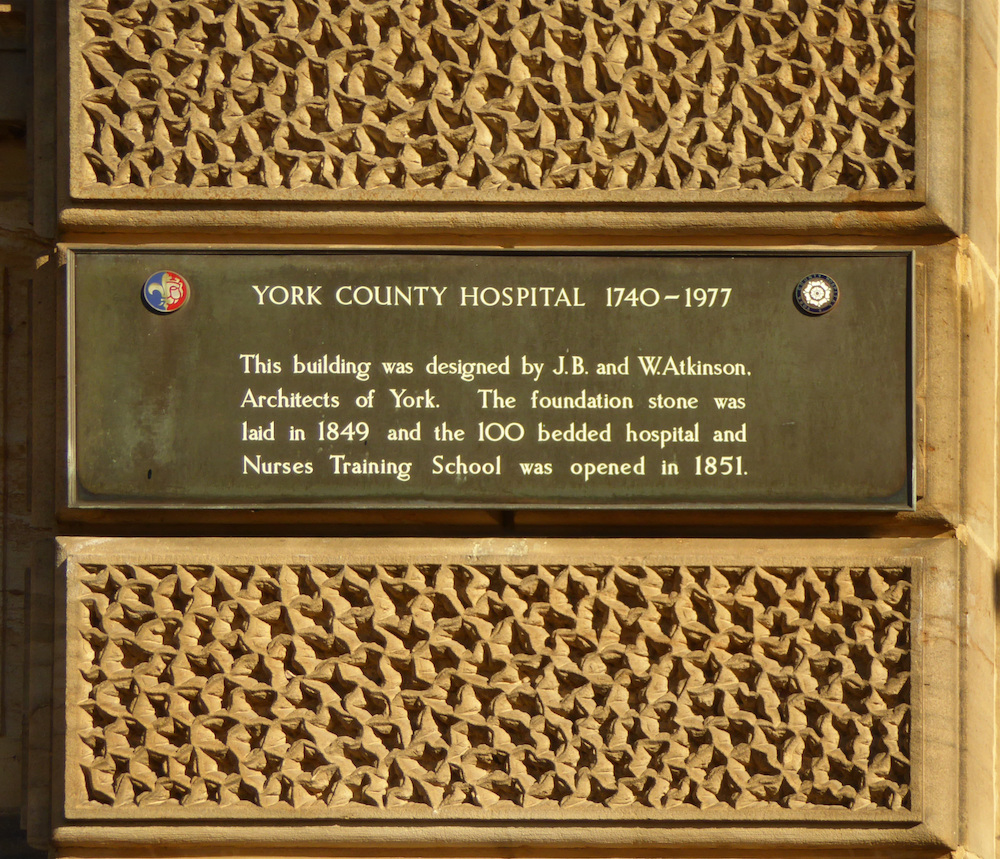Photographs by the author unless otherwise specified. Formatting by Jacqueline Banerjee. You may use these images without prior permission for any scholarly or educational purpose as long as you (1) credit the photographer and (2) link your document to this URL, or cite it in a print one. [Click on the images to enlarge them.]

Former York County Hospital, 32 Monkgate, York, seen from the west (approached through Monkgate Cloisters on the east side of Monkgate). The architects of this Grade II listed building were J. B. & W. Atkinson, and it was built in 1849-51: "one of their best buildings," say David Neave and Nikolaus Pevsner (247); largely red brick, it has fifteen bays and three floors, and a slate roof. It had a hundred beds and was a charitable foundation, originating in funds bequeathed by Lady Elizabeth Hastings, who died in 1739. It had cost £11,000, met by £7,000 from subscriptions, and £4,000 which had accumulated in the charity's funds (see Tillott).


Left: The east side. Left: The south end.
The hospital was closed in 1977, restored as offices in 1985 and is now flats (or as we say now, apartments). It is called "County House" in the heritage listing, which refers to its period as offices.



Left to right: (a) Looking along the front. (b) The main entrance. (c) The doorway.


Left: Looking up at the dentilled stone cornice under the eaves. Right: A closer view of the cornice.
History


Left: Old photograph by William Pumphrey, taken looking roughly north, c. 1850-57 (courtesy of the Evelyn Collection). Right: The Civic Trust plaque.
The hospital was in an area of development in the 1850s; this is shown in the photograph by William Pumphrey, taken looking roughly north. On the left is seen one end of the city walls with a dilapidated brick and stone tower restored by George Fowler Jones in 1857, and on the low ground to the right is the course of a planned new road aiming at the old Layerthorpe Bridge; now Foss Islands Road. In the distance (600m away), the large block of the new County Hospital is striking. It is unfortunate the photograph has faded in that area, but the scale of the building can still be glimpsed, and is still impressive.
According to P. M. Tillott,
The average annual income was about £4,100 in the years 1858-67, and about £6,450 in 1890-9. Additions to the hospital during this period were the Watt Wing, built from a bequest of £5,000 from William Watt of Bishop Burton (E[ast] R[iding]) and opened in 1884, and a children's wing opened in 1899. In 1887 the York Institution for Diseases of the Eye was amalgamated with the County Hospital; it had been established in the Merchant Tailors' Hall, Aldwark, in 1831 for poor patients. A similar service for diseases of the ear was provided by an institution opened in 1851; it was said to be in the Merchant Adventurer's Hall in 1855 and may have been amalgamated with the County Hospital together with the eye institute.... Additional funds were raised in the early 20th century by a number of voluntary bodies, among them the York Workpeople's Hospital Committee, founded in 1901.
It is interesting to see how hospital services were founded and funded before the establishment of the National Health Service close to the middle of the twentieth-century.
Related Material
Bibliography
County House. Historic England. Web. 28 November 2020.
Pevsner, Nikolaus, and David Neave. Yorkshire: York and the East Riding. New Haven and London: Yale University Press, 2002.
Tillott, P. M., ed. "Public services." In A History of the County of York: the City of York. London, 1961: 460-472. British History Online. Web. 28 November 2020.
York County Hospital: 55. York Civic Trust. Web. 28 November 2020.
Created 29 November 2020